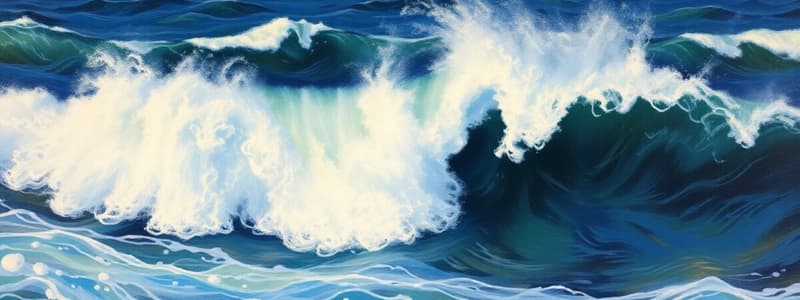Podcast
Questions and Answers
What is the most common cause of ocean waves?
What is the most common cause of ocean waves?
- The gravitational pull of the moon and sun.
- Underwater earthquakes and volcanic eruptions.
- Large marine animals displacing water.
- Friction between wind and the water's surface. (correct)
Ocean waves primarily facilitate the movement of what through water?
Ocean waves primarily facilitate the movement of what through water?
- Water and energy equally in all directions.
- Energy vertically and horizontally through the water.
- Energy vertically through water with minimal water displacement. (correct)
- Water molecules horizontally across the surface.
Which of the following accurately describes the wave crest and wave trough?
Which of the following accurately describes the wave crest and wave trough?
- The wave crest is the highest point, and the wave trough is the lowest point of a wave. (correct)
- Both the wave crest and trough represent points of zero energy in a wave.
- The wave crest indicates the start of a wave, and the wave trough indicates the end of a wave.
- The wave crest is the lowest point, and the wave trough is the highest point of a wave.
What term is used to describe groups of waves that commonly travel together?
What term is used to describe groups of waves that commonly travel together?
Which of the following types of ocean waves are discussed in the provided content?
Which of the following types of ocean waves are discussed in the provided content?
Which wave type is primarily generated by major storms such as hurricanes in the open ocean?
Which wave type is primarily generated by major storms such as hurricanes in the open ocean?
What characteristic of the shoreline primarily determines whether waves break as spilling breakers?
What characteristic of the shoreline primarily determines whether waves break as spilling breakers?
Despite both being large waves, what is a key differentiating factor between tidal waves and tsunamis?
Despite both being large waves, what is a key differentiating factor between tidal waves and tsunamis?
Besides causing natural disasters, what is a significant long-term effect of ocean waves on coastlines?
Besides causing natural disasters, what is a significant long-term effect of ocean waves on coastlines?
Surfers often prefer plunging breakers because of the formation of 'barrels'. What type of shoreline contributes to the formation of plunging breakers?
Surfers often prefer plunging breakers because of the formation of 'barrels'. What type of shoreline contributes to the formation of plunging breakers?
Flashcards
Wave Crest
Wave Crest
The highest point of a wave.
Wave Trough
Wave Trough
The lowest point of a wave.
Wave Train
Wave Train
A group of waves traveling together.
Wind Waves
Wind Waves
Signup and view all the flashcards
Tsunamis
Tsunamis
Signup and view all the flashcards
Ocean Swells
Ocean Swells
Signup and view all the flashcards
Tidal Waves
Tidal Waves
Signup and view all the flashcards
Spilling Breaker
Spilling Breaker
Signup and view all the flashcards
Study Notes
Ocean Wave Basics
- Ocean waves are created by wind friction, abrupt ocean disruptions, or tidal movements.
- Waves are the movement of energy, not water itself; water molecules move up and down, not horizontally.
- Commonly observed near shorelines where wave interaction with the ocean floor increases wave height.
- Wave height and movement are influenced by the shape of the ocean floor.
Wave Formation
- Most waves are surface waves, created by wind-water friction transferring energy through the water.
- Wind patterns, influenced by Earth's rotation and heating at the equator, generate consistent wave formations.
- Buoys bob up and down due to wave energy passing through the water.
- Wave energy travels without substantial water movement.
Parts of a Wave
- A wave consists of a wave crest (highest point) and a wave trough (lowest point).
- Water molecules move vertically due to the passing wave energy.
- Waves frequently travel in groups called wave trains.
Types of Ocean Waves
- Tsunamis: Caused by powerful earth disturbances like earthquakes, volcanic eruptions, or landslides. They are large, destructive waves.
- Wind Waves: Common surface waves generated by wind friction with the ocean's surface. Wave size varies with wind strength and duration.
- Ocean Swells: Large, mature waves that travel across vast distances of open ocean, often caused by major storms.
- Tidal Waves: Not actually waves but large water bulges caused by tidal forces. They are predicatable.
Breaking Waves
- Spilling Breakers: Occur on gently sloping shores, energy dissipates gradually, creating a wave that spills over the front.
- Plunging Breakers: Occur on steeply sloped shorelines. Waves curl over themselves creating a plunge. Plunging breakers are favored by surfers.
Effects of Ocean Waves
- Large waves, like tsunamis and some tidal waves, can cause widespread devastation.
- Ocean waves contribute to the gradual erosion of coastlines.
- Shoreline erosion is accelerated or lessened by human activities along the coast.
- Waves contribute to the formation of various coastal landforms like cliffs, caves, and barrier islands.
Studying That Suits You
Use AI to generate personalized quizzes and flashcards to suit your learning preferences.




